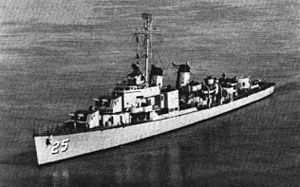
USS Richard W. Suesens (DE-342) was a John C. Butler-class destroyer escort in service with the United States Navy from 1944 to 1947. She was finally sold for scrap in 1973.

USS Rodman (DD-456/DMS-21), a Gleaves-class destroyer, is the first ship of the United States Navy to be named for Admiral Hugh Rodman.

USS Zeal (AM-131) was an Auk-class minesweeper that served in both World War II and during the Korean War. As a steel-hulled fleet minesweeper, she was assigned to support the fleet by removing enemy mines whose purpose was to impede the path of the U.S. Pacific Fleet.
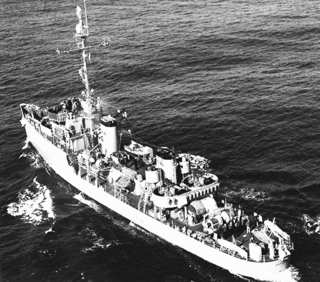
USS Defense (AM-317) was an Auk-class minesweeper acquired by the United States Navy for the dangerous task of removing mines from minefields laid in the water to prevent ships from passing.

USS Jeffers (DD-621/DMS-27), a Gleaves-class destroyer, was the only ship of the United States Navy to be named for Commodore William N. Jeffers.

USS Bunch (DE-694) was a Buckley-class destroyer escort of the United States Navy, named after Kenneth Cecil Bunch, killed in action on 6 June 1942 while flying as radioman-gunner in an SBD Dauntless dive bomber during the Battle of Midway. Bunch was a native of Norman County, Minnesota.
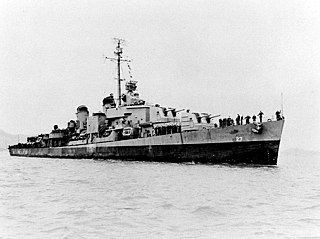
USS Adams (DM-27) was a destroyer minelayer in the United States Navy. She was named for Lieutenant, junior grade Samuel Adams. The other two USS Adams that have existed were named after the second president.

USS Thomas E. Fraser (DD-736/DM-24) was a Robert H. Smith-class destroyer minelayer in the United States Navy.

USS Tolman (DD-740/DM-28/MMD-28) was a Robert H. Smith-class destroyer minelayer in the United States Navy.
USS Serene (AM-300) was an Admirable-class minesweeper built for the United States Navy during World War II. She served in the Pacific Ocean and was awarded six battle stars. She was decommissioned and placed in reserve in 1946. In January 1964, the former Serene was transferred to South Vietnam as RVNS Nhật Tảo (HQ-10) in the Republic of Vietnam Navy. She was sunk in January 1974 during combat with Chinese forces in the Battle of the Paracel Islands.
USS Pochard (AM-375) was an Auk-class minesweeper acquired by the United States Navy for the dangerous task of removing mines from minefields laid in the water to prevent ships from passing.
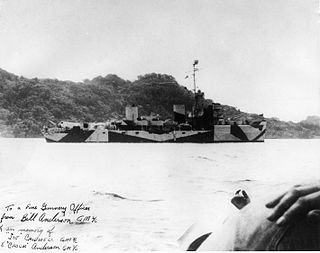
USS Velocity (AM-128) was an Auk-class minesweeper acquired by the United States Navy for the dangerous task of removing mines from minefields laid in the water to prevent ships from passing. She was the second warship to bear the name.
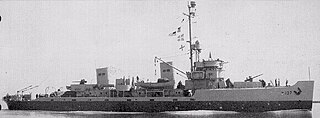
USS Prevail (AM-107) was an Auk-class minesweeper acquired by the United States Navy for the dangerous task of removing mines from minefields laid in the water to prevent ships from passing.
USS Sage (AM-111) was an Auk-class minesweeper acquired by the United States Navy for the dangerous task of removing naval mines.

USS Staff (AM-114) was an Auk-class minesweeper acquired by the United States Navy for the dangerous task of removing mines from minefields laid in the water to prevent ships from passing.
USS Token (AM-126) was an Auk-class minesweeper acquired by the United States Navy for the dangerous task of removing mines from minefields laid in the water to prevent ships from passing.
USS Tumult (AM-127) was an Auk-class minesweeper acquired by the United States Navy for the dangerous task of removing mines from minefields laid in the water to prevent ships from passing.

USS Robin was a YMS-1-class minesweeper of the YMS-135 subclass built for the United States Navy during World War II.
USS Superior (AM-311) was a steel-hulled Admirable-class minesweeper built for the U.S. Navy in 1944. Superior participated in the final struggle in the Pacific Ocean against the Empire of Japan during the end of World War II and remained behind, after the war ended, to clear minefields laid during the war.
USS Hilarity (AM-241) was an Admirable-class minesweeper built for the United States Navy during World War II. She was awarded two battle stars for service in the Pacific during World War II. She was decommissioned in 1946 and placed in the Atlantic Reserve Fleet. While she remained in reserve, Hilarity was reclassified as MSF-241 in February 1955 but never reactivated. In October 1962, she was sold to the Mexican Navy and renamed ARM DM-02. She was stricken in 1986 and scrapped in August 1988.
